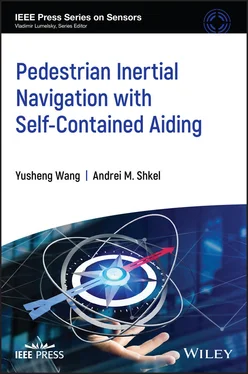One of the most straightforward methods is to use landmarks. Generally speaking, a landmark can be anything with known coordinates in a reference frame. For example, any position on the surface of the Earth can be described by its latitude and longitude, defined by the Earth's equator and Greenwich meridian. The landmarks can be hills and rivers in the wilderness, or streets and buildings in urban areas, or lighthouses and even celestial bodies when navigating on the sea. Other modern options, such as radar stations, satellites, and cellular towers, can all be utilized as landmarks. The position of the navigator can be extracted by measuring the distance to, and/or the orientation with respect to the landmarks. For example, celestial navigation is a well‐established technique for navigation on the sea. In this technique, “sights,” or angular distance is measured between a celestial body, such as the Sun, the Moon, or the Polaris, and the horizon. The measurement, combined with the knowledge of the motion of the Earth, and time of measurement, is able to define both the latitude and longitude of the navigator [2]. In the case of satellite navigation, a satellite constellation composed of many satellites with synchronized clocks and known positions, and continuously transmitting radio signal is needed. The receiver can measure the distance between itself and the satellites by comparing the time difference between the signal that is transmitted by the satellite and received by the receiver. A minimum of four satellites must be in view of the receiver for it to compute the time and its location [3]. Navigation methods of this type, which utilize the observation of landmarks with known positions to directly determine a position, are called the position fixing. In the position fixing type of navigation, navigation accuracy is dependent only on the accuracy of the measurement and the “map” (knowledge of the landmarks). Therefore, navigation accuracy remains at a constant level as navigation time increases, as long as observations of the landmarks are available.
The idea of position fixing is straightforward, but the disadvantage is also obvious. Observation of landmarks may not always be available and is susceptible to interference and jamming. For example, no celestial measurement is available in foggy or cloudy weather; radio signals suffer from diffraction, refraction, and Non‐Line‐Of‐Sight (NLOS) transmission; satellite signals may also be jammed or spoofed. Besides, a known “map” is required, which makes this type of navigation infeasible in the completely unknown environment.
An alternative navigation type is called dead reckoning. The phrase “dead reckoning” probably dated from the seventeenth century, when the sailors calculated their location on the sea based on the velocity and its orientation. Nowadays, dead reckoning refers to the process where the current state (position, velocity, and orientation) of the system is calculated based on the knowledge of its initial state and measurement of speed and heading [4]. Velocity is decomposed into three orthogonal directions based on heading and then multiplied by the elapsed time to obtain the position change. Then, the current position is calculated by summing up the position change and the initial position. A major advantage of dead reckoning over position fixing is that it does not require the observations of the landmarks. Thus, the system is less susceptible to environmental interruptions. On the other hand, dead reckoning is subject to cumulative errors. For example, in automotive navigation, the odometer calculates the traveled distance by counting the number of rotations of a wheel. However, slipping of the wheel or a flat tire will result in a difference between the assumed and actual travel distance, and the error will accumulate but cannot be measured or compensated, if no additional information is provided. As a result, navigation error will be accumulated as navigation time increases.
Inertial navigation is a widely used dead reckoning method, where inertial sensors (accelerometers and gyroscopes) are implemented to achieve navigation purpose in the inertial frame. The major advantage of inertial navigation is that it is based on the Newton's laws of motion and imposes no extra assumptions on the system. As a result, inertial navigation is impervious to interference and jamming, and its application is universal in almost all navigation scenarios [5].
The operation of inertial navigation relies on the measurements of accelerations and angular rates, which can be achieved by accelerometers and gyroscopes, respectively. In a typical Inertial Measurement Unit (IMU), there are three accelerometers and three gyroscopes mounted orthogonal to each other to measure the acceleration and angular rate components along three perpendicular directions. To keep track of the orientation of the system with respect to the inertial frame, three gyroscopes are needed. Gyroscopes measure the angular rates along three orthogonal directions. Angular rates are then integrated, and the orientation of the system is derived from these measurements. The readout of the accelerometers is called the specific force, which is composed of two parts: the gravity vector and the acceleration vector. According to the Equivalence Principle in the General Theory of Relativity, the inertial force and the gravitational force are equivalent and cannot be separated by the accelerometers. Therefore, the orientation information obtained by the gyroscopes is needed to estimate the gravity vector. With the orientation information, we can subtract the gravity vector from the specific force to obtain the acceleration vector, and revolve the acceleration vector from the system frame to the inertial frame before performing integration. Given the accelerations of the system, the change of position can be calculated by performing two consecutive integrations of the acceleration with respect to time.
The earliest concept of inertial sensor was proposed by Bohnenberger in the early nineteenth century [6]. Then in 1856, the famous Foucault pendulum experiment was demonstrated as the first rate‐integrating gyroscope [7], whose output is proportional to the change of angle, instead of the angular rate as in the case of most commercial gyroscopes. However, the first implementation of an inertial navigation system did not occur until the 1930s on V2 rockets and the wide application of inertial navigation started in the late 1960s [8]. In the early implementation of inertial navigation, inertial sensors are fixed on a stabilized platform supported by a gimbal set with rotary joints allowing rotation in three dimensions ( Figure 1.1). The gyroscope readouts are fed back to torque motors that rotates the gimbals so that any external rotational motion could be canceled out and the orientation of the platform does not change. This implementation is still in common use where very accurate navigation data is required and the weight and volume of the system are not of great concern, such as in submarines. However, the gimbal systems are large and expensive due to their complex mechanical and electrical infrastructure. In the late 1970s, strapdown system was made possible, where inertial sensors are rigidly fixed, or “strapped down” to the system. In this architecture, the mechanical complexity of the platform is greatly reduced at the cost of substantial increase in the computational complexity in the navigation algorithm and a higher dynamic range for gyroscopes. However, recent development of microprocessor capabilities and suitable sensors allowed such design to become reality. The smaller size, lighter weight, and better reliability of the system further broaden the applications of the inertial navigation. Comparison of the schematics of algorithmic implementations in gimbal system and strapdown system is shown in Figure 1.2.
Читать дальше











